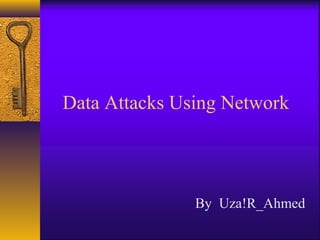Uzair ppt
- 1. Data Attacks Using Network By Uza!R_Ahmed
- 2. Data Attack âĶ In computer and computer networks an attack is any attempt to destroy, expose, alter, disable, steal or gain unauthorized access to or make unauthorized use of an asset.
- 3. Tools used in Network Attacks âĶ Sniffing âĶ Spoofing âĶ Session hijacking âĶ Netcat
- 4. Sniffer âĶ Allows attacker to see everything sent across the network, including userIDs and passwords âĶ Tcpdump http://www.tcpdump.org âĶ Windump http://netgroup-serv.polito.it/windump âĶ Snort http://www.snort.org âĶ Ethereal http://www.ethereal.com âĶ Sniffit http://reptile.rug.ac.be/~coder/sniffit/sniffit.html âĶ Dsniff http://www.monkey.org/~dugsong/dsniff
- 5. Island Hopping Attack âĶ Attacker initially takes over a machine via some exploit âĶ Attacker installs a sniffer to capture userIDs and passwords to take over other machines
- 6. Figure An island hopping attack
- 7. Passive Sniffers âĶ Sniffers that passively wait for traffic to be sent to them âĶ Well suited for hub environment âĶ Snort âĶ Sniffit
- 8. Figure A LAN implemented with a hub
- 9. Sniffit in Interactive Mode âĶ Useful for monitoring session-oriented applications such as telnet and ftp âĶ Activated by starting sniffit with â-iâ option âĶ Sorts packets into sessions based on IP addresses and port numbers âĶ Identifies userIDs and passwords âĶ Allows attacker to watch keystrokes of victim in real time.
- 10. Switched Ethernet LANs âĶ Forwards network packets based on the destination MAC address in the Ethernet header
- 11. Figure A LAN implemented with a switch
- 12. Active Sniffers âĶ Effective in sniffing switched LANs âĶ Injects traffic into the LAN to redirect victimâs traffic to attacker
- 13. Figure In a person-in-the-middle attack, the attacker can grab or alter traffic between Alice and Bob
- 14. Sniffing Defenses âĶ Use HTTPS for encrypted web traffic âĶ Use SSH for encrypted login sessions â Avoid using Telnet âĶ Use S/MIME or PGP for encrypted email âĶ Pay attention to warning messages on your browser and SSH client
- 15. Network-based Session Hijacking âĶ Attack based on sniffing and spoofing âĶ Occurs when attacker steals user session such as telent, rlogin, or FTP. â Innocent user thinks that his session was lost, not stolen âĶ Attacker sits on a network segment where traffic between victim and server can be seen âĶ Attacker injects spoofed packets contain source IP address of victim with proper TCP sequence numbers âĶ If hijack is successful, server will obey all commands sent by attacker.
- 16. Figure A network-based session hijacking scenario
- 17. Session Hijacking Defenses âĶ Use SSH or VPN for securing sessions â Attackers will not have the keys to encrypt or decrypt traffic â Pay attention to warning messages about any change of public key on server since this may be a person-in-the-middle attack
- 18. Netcat âĶ Network version of âcatâ utility âĶ Allows user to move data across a network using any TCP or UDP port âĶ Runs on both Unix and Windows NT âĶ Netcat executable âncâ operates in two modes â Client mode allows user to initiate connection to any TCP or UDP on a remote machine and to take input data from standard input (eg keyboard or output of pipe) â Listen mode (-l option) opens any specified TCP or UDP port on local system and waits for incoming connection and data through port. Data collected is sent to standard output (eg. Screen or input of pipe)



















